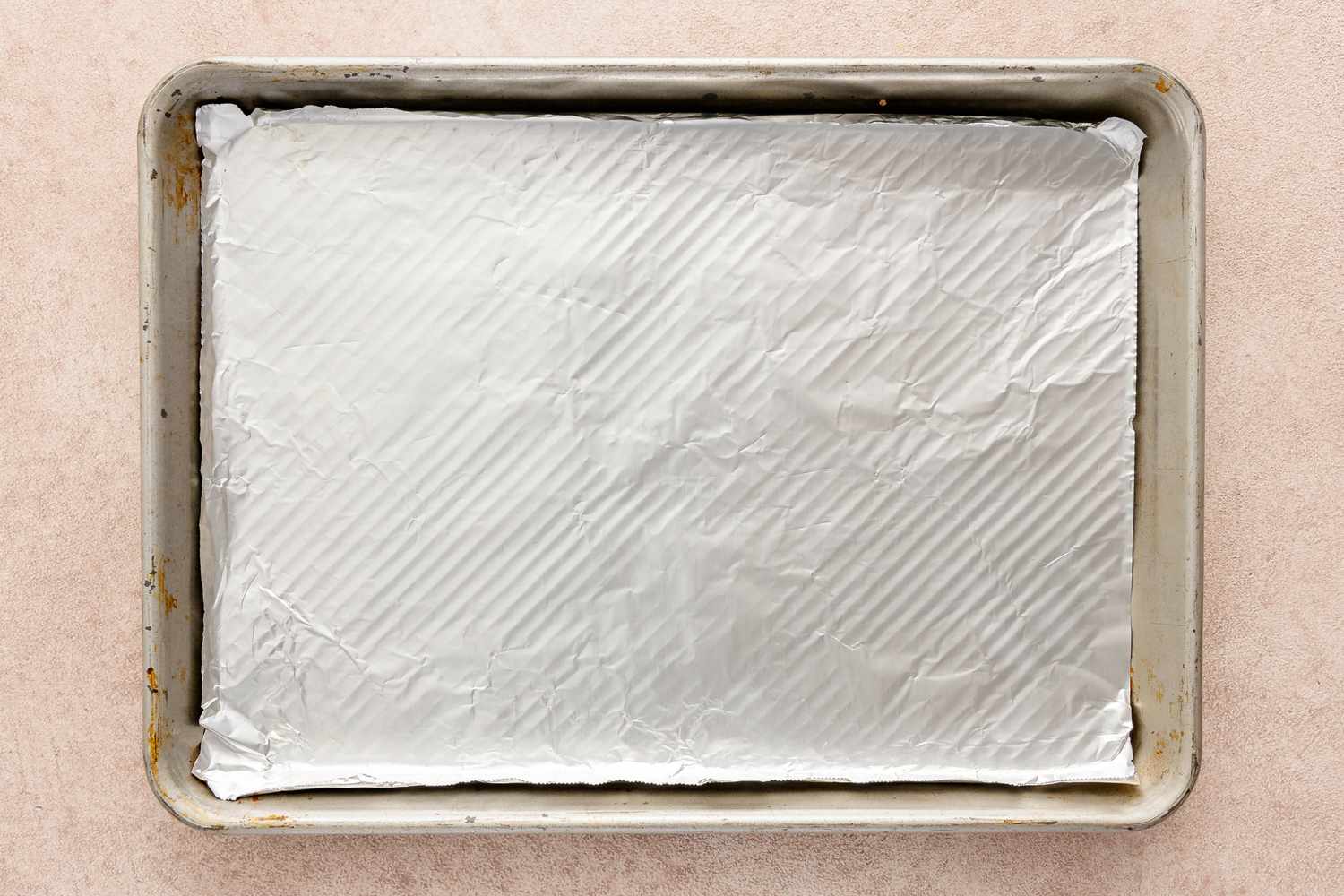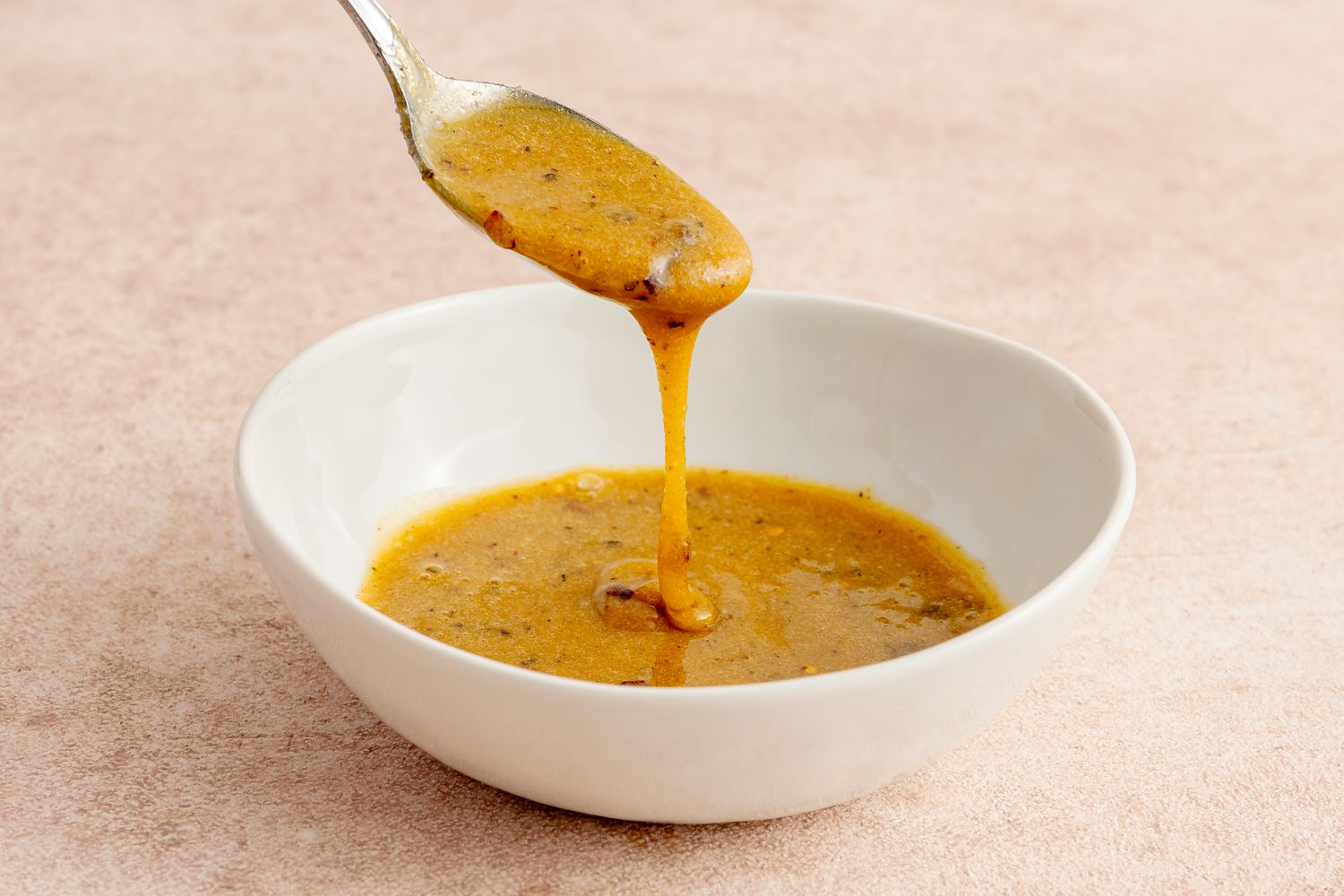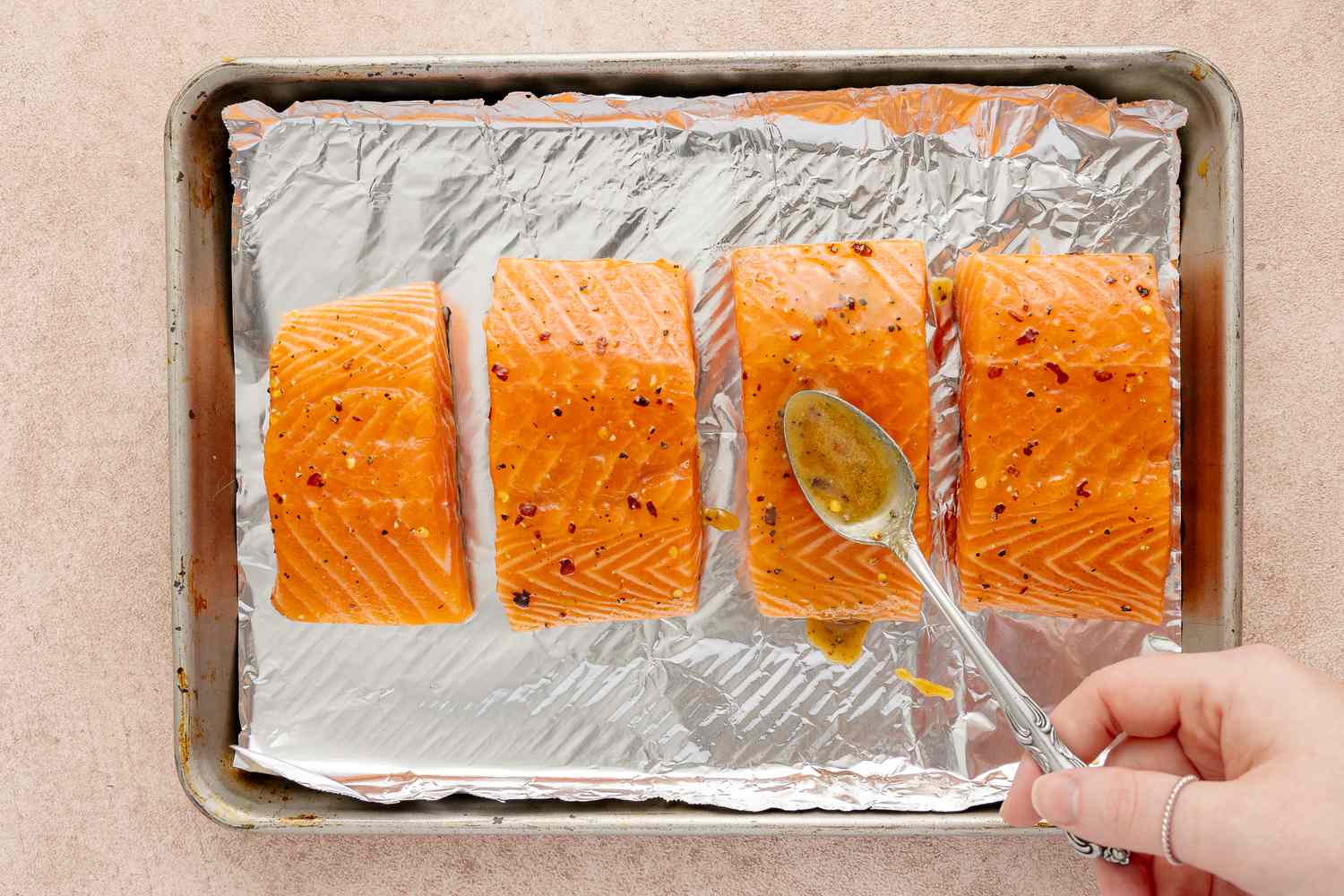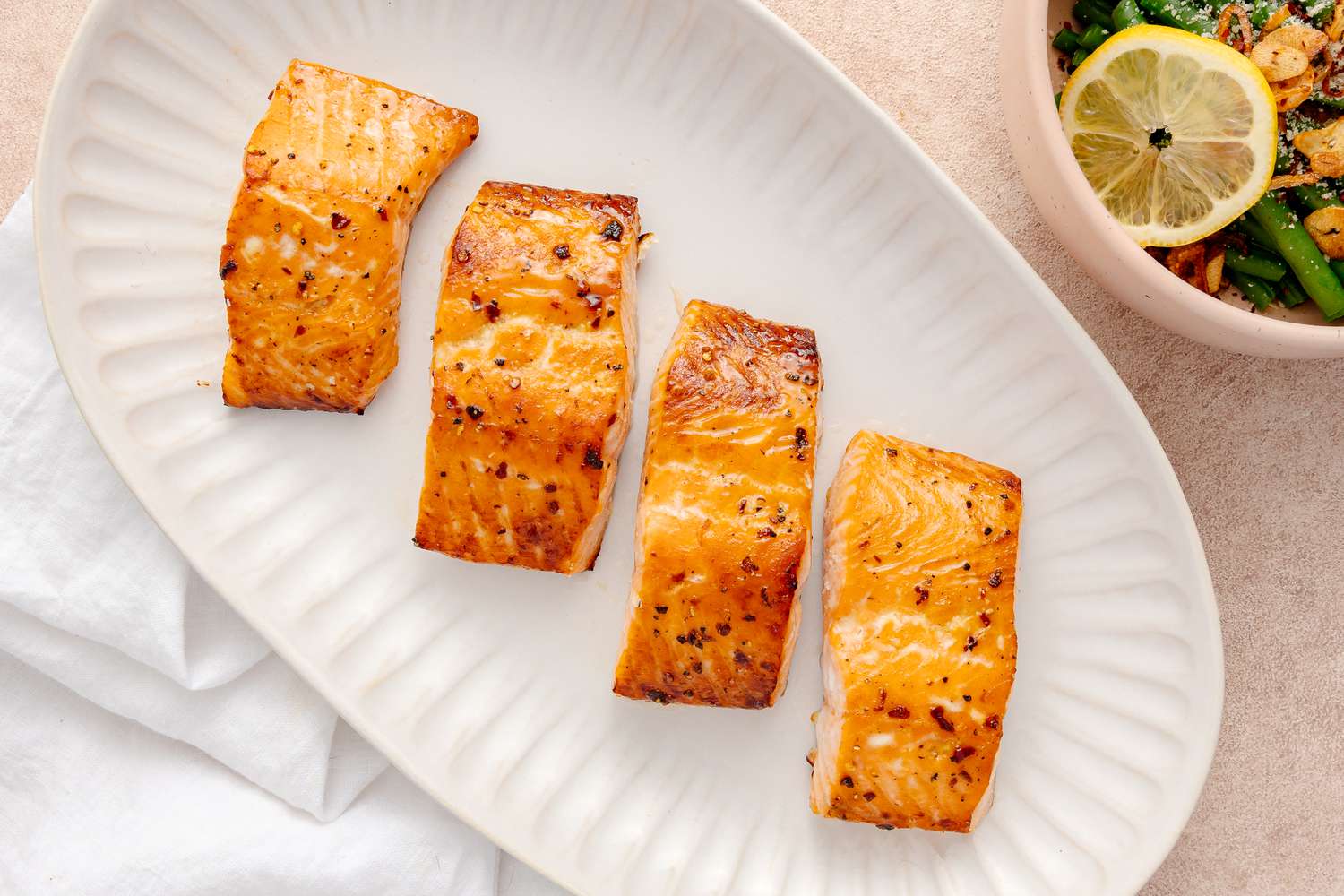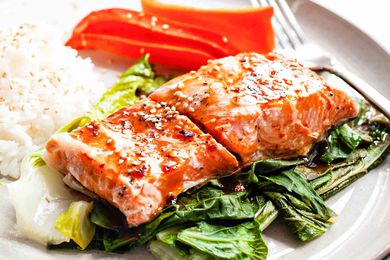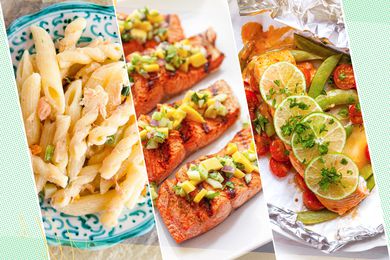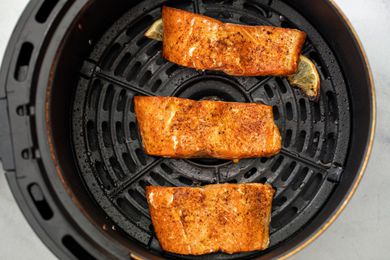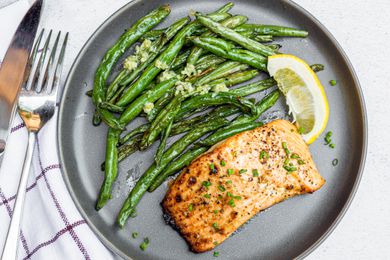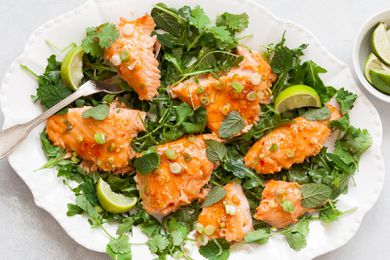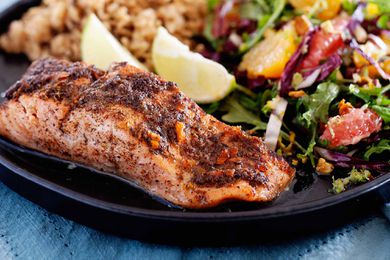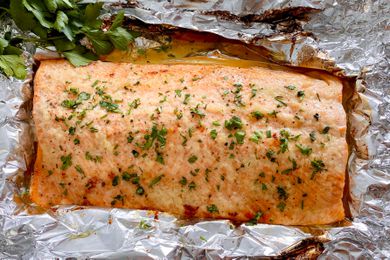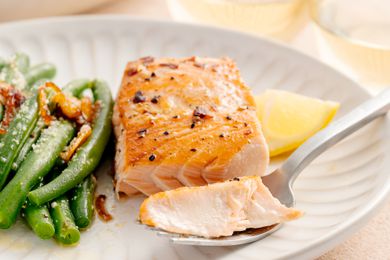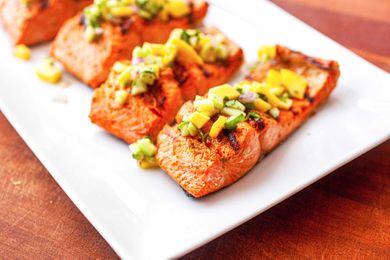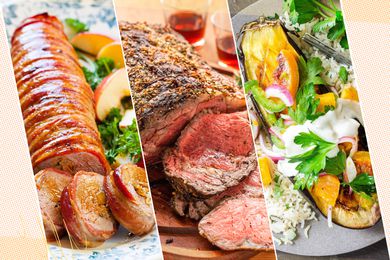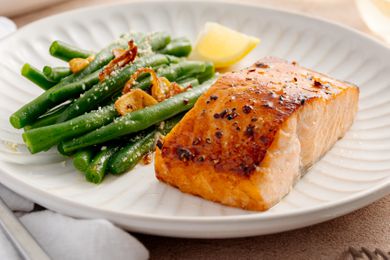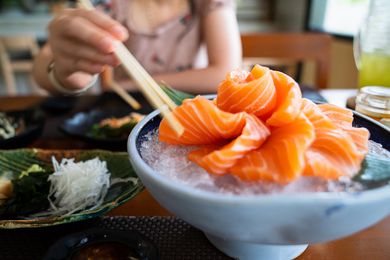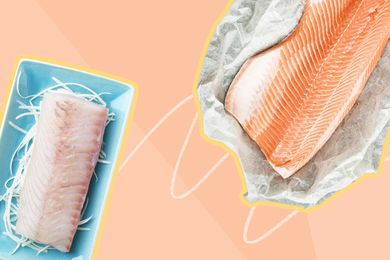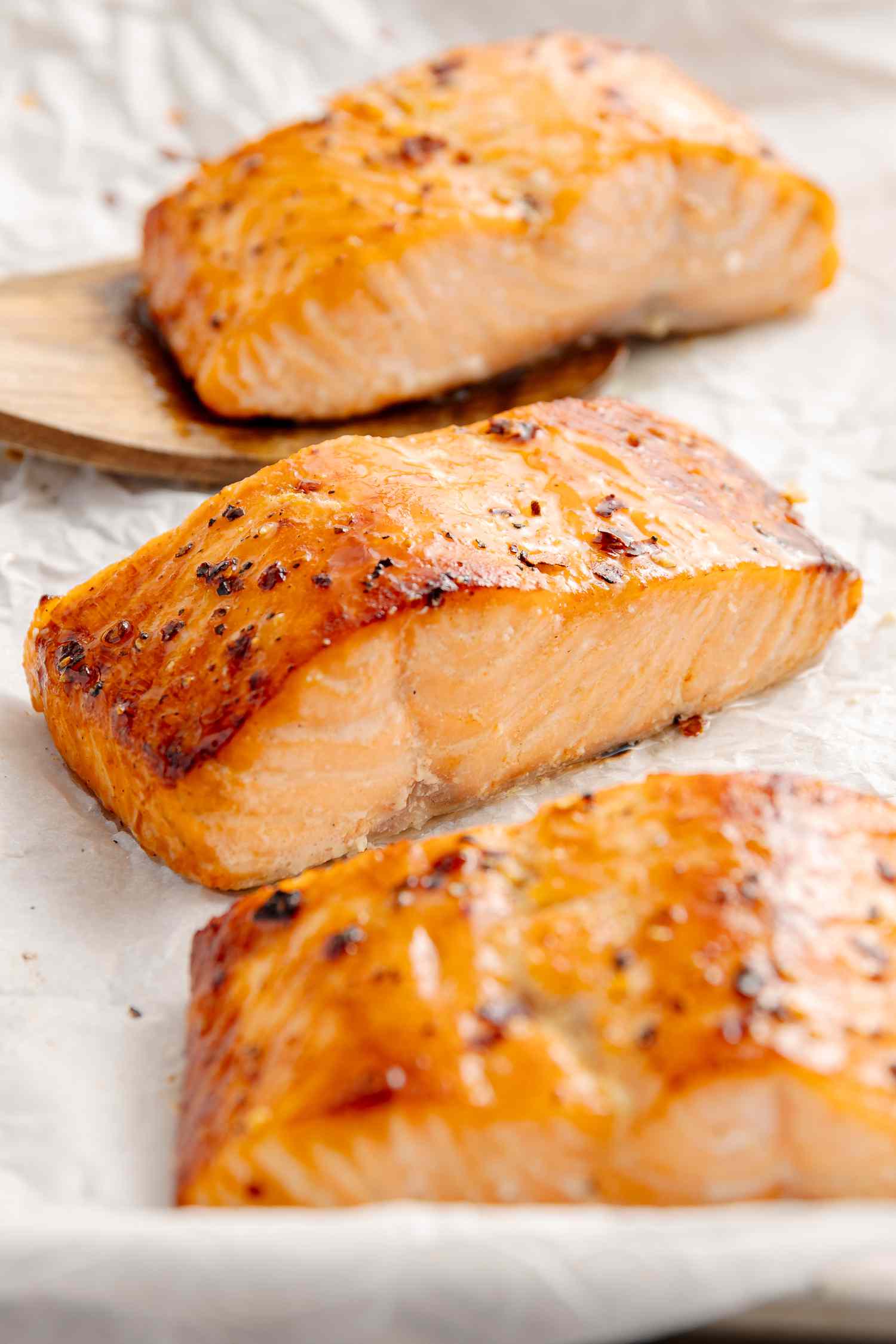
Simply Recipes / Ciara Kehoe
This baked salmon shimmers with a sweet brown sugar and Dijon glaze—some spots on top crisp up thanks to the high oven temp. It bakes in 12 minutes tops and is full of health benefits (hello, Omega-3s and DHA).
Serve this versatile baked salmon for an elegant dinner party or and as I often do, for a quick and healthy weeknight dinner.
I Didn’t Always Love Salmon
I once loathed fish. I grew up south of Cleveland, Ohio with little access to fresh fish and my parents basically never served it. Fast forward about 15 years, my husband and I moved to Brooklyn. Our new home was around the corner from a little fish shop called Fish Tales. This is where my love affair with salmon began.
The fish was so fresh and so buttery even baked with just salt and pepper. There wasn’t a week I didn’t stop by for 1 1/4 pounds of wild caught salmon—an order the monger came to memorize, another reason I came to love it there.
Over time, I mastered the perfect oven temperature and cook times for baked salmon, and significantly increased my levels of omega-3 fatty acids. I hope this small victory story allows you to put your trust me. You’re going to love this baked salmon with brown sugar glaze!
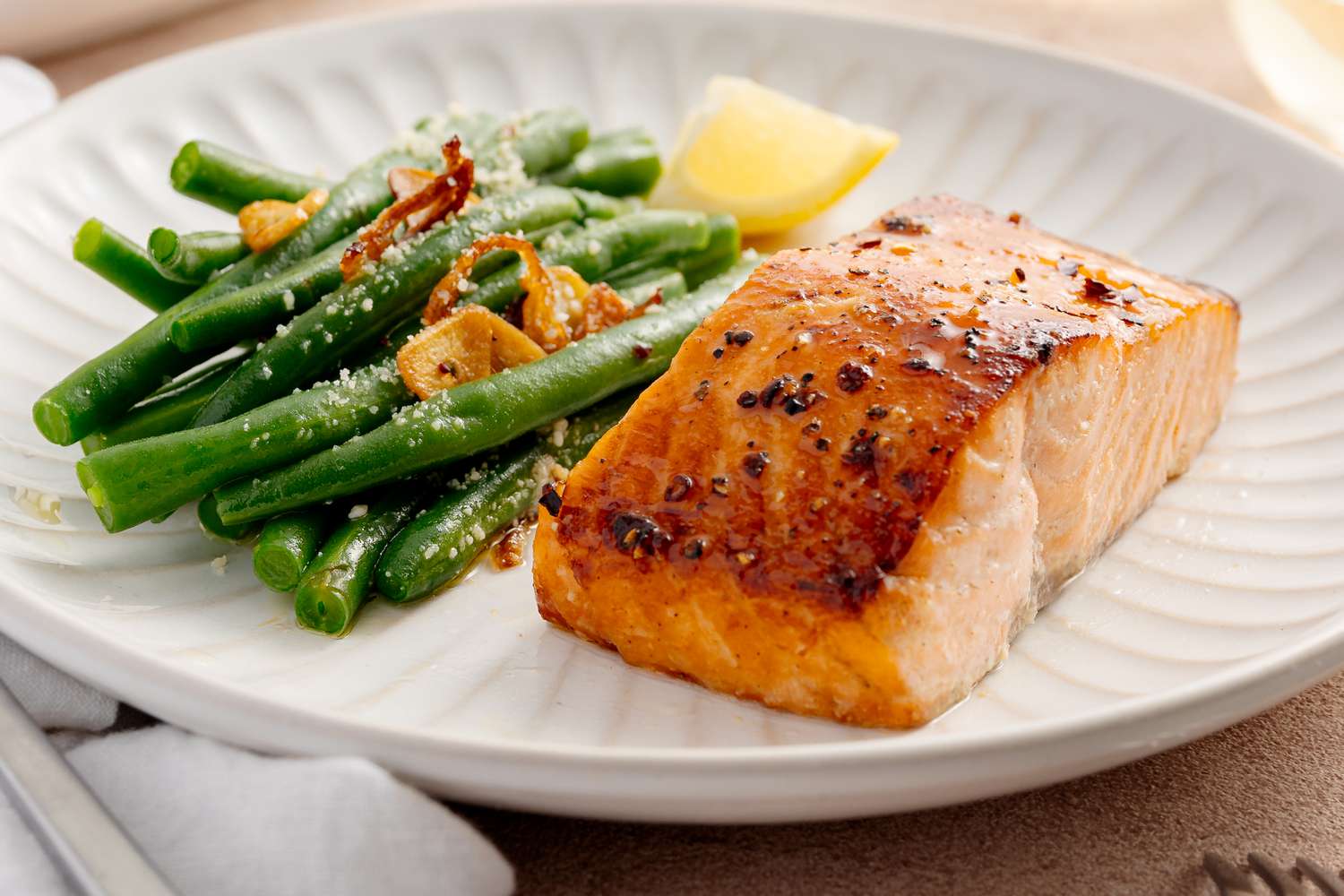
Simply Recipes / Ciara Kehoe
The Best Salmon for Baking
The good news is that all salmon are well suited for baking. There are many varieties to choose from, likecoho or chinook. My only advice is to buy the best quality salmon that you can afford. Here are a few interesting facts that I hope will help you make an educated decision:
- Cues for the best salmon: Look for fish that has super silvery skin and flesh that is moist and bright in color. Steer clear if it smells too “fishy” or if it’s dull and slimy.
- Wild caught vs. farm raised: It is important to me that the salmon I buy be wild caught and sustainably harvested. That typically means it’s a Pacific or Alaskan salmon. Farm raised salmon are bred in pens, which can be a breeding ground for harmful toxins. Salmon labeled as Atlantic is most likely farm raised since fishing for wild Atlantic salmon is illegal in the U.S. For good measure, check the Monterey Bay Aquarium Seafood Watch to learn best practices for buying fish.
- Organic? Fun fact: There is no USDA label for organic salmon or any fish for that matter. Salmon labeled as organic has most likely been farmed.
- Fresh vs frozen: I don’t typically like to deal with thawing frozen fish, especially when I need an impromptu weeknight dinner. However, it’s a great option if you do not procrastinate like your author here. Frozen salmon is flash frozen upon catching to gear up for the long road to markets and grocery stores—this retains its freshness. To thaw, place the frozen fish on a plate and pop it in the fridge the night before you plan to serve it.
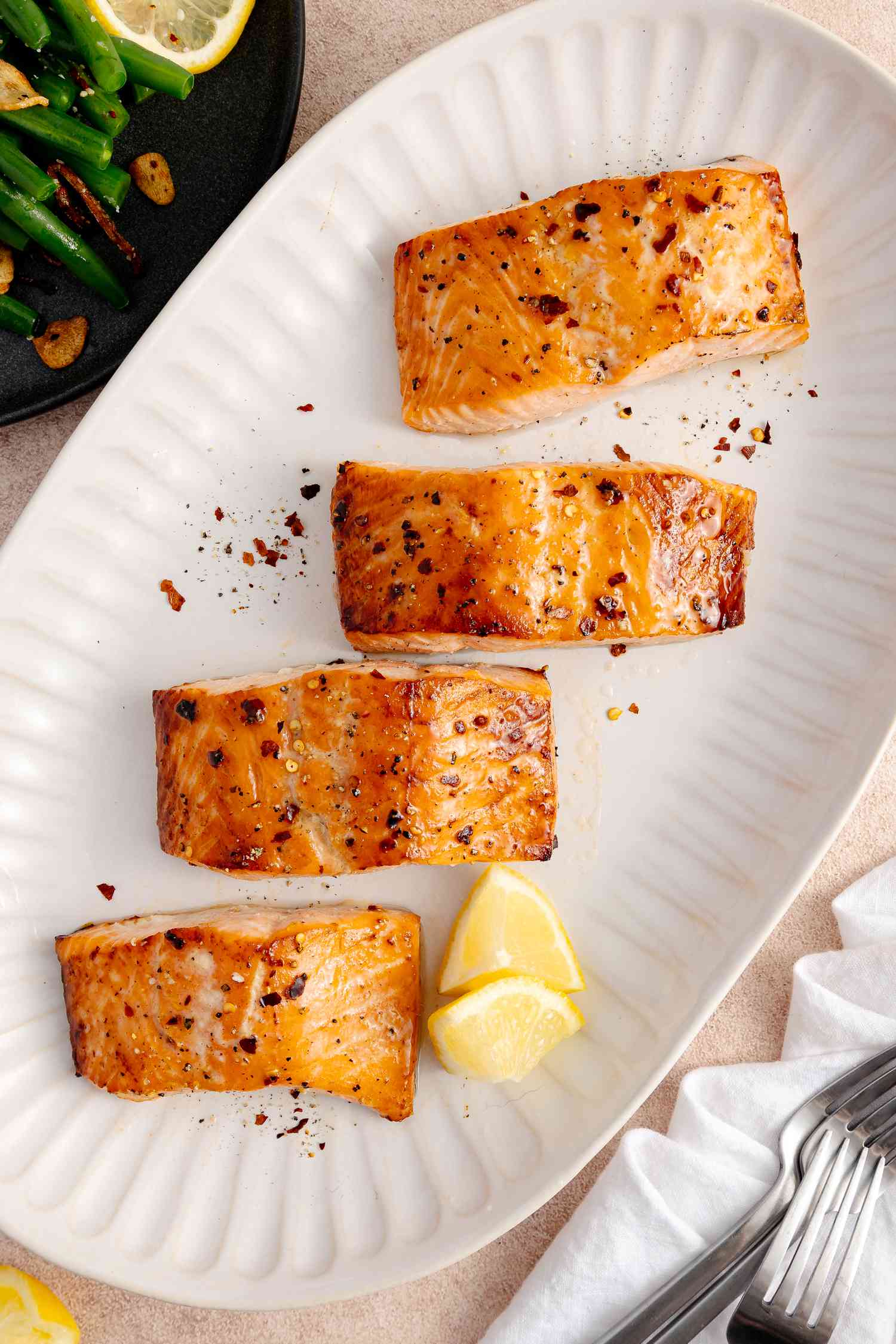
Simply Recipes / Ciara Kehoe
The Case for Skin-On Salmon
Salmon skin is polarizing. The skin is very flavorful—those of you who are fans know it is edible. Whether you like to eat it or not, I recommend buying and baking salmon with the skin on. It provides a barrier between the fish and the hot pan, protecting the fish.
For the non-skin eating salmon lovers out there, it makes serving the baked salmon much easier, the spatula can slide right through the tiny pathway between the skin and flesh releasing it from the sheet pan.
Pro Tips for Perfectly Baked Salmon
- Full disclosure: I have a favorite oven temperature. Weird, I know. But baking things, all sorts of yummy things at 425°F has rewarded me with a multitude of delicious meals. And that includes salmon. Bake salmon at 425°F for 12 to 14 minutes—I know it by memory! Its yields juicy and beautifully glazed salmon with large, tender flakes. Now go on and try it out, then circle back with me. I bet it’ll become your favorite oven temperature too.
- Loathe the fact that the skinny ends of salmon cooks faster? Simply tuck the thin ends under. It will cook a touch more evenly.
- Bring your salmon to room temperature before baking. This will help cook it evenly.
Line the Sheet Pan with Foil
When baking salmon, line the sheet pan with foil. The salmon skin will not get crispy enough to release from the sheet pan like it would in a hot skillet. The foil will prevent the skin from sticking to the sheet pan, making clean up a lot easier.
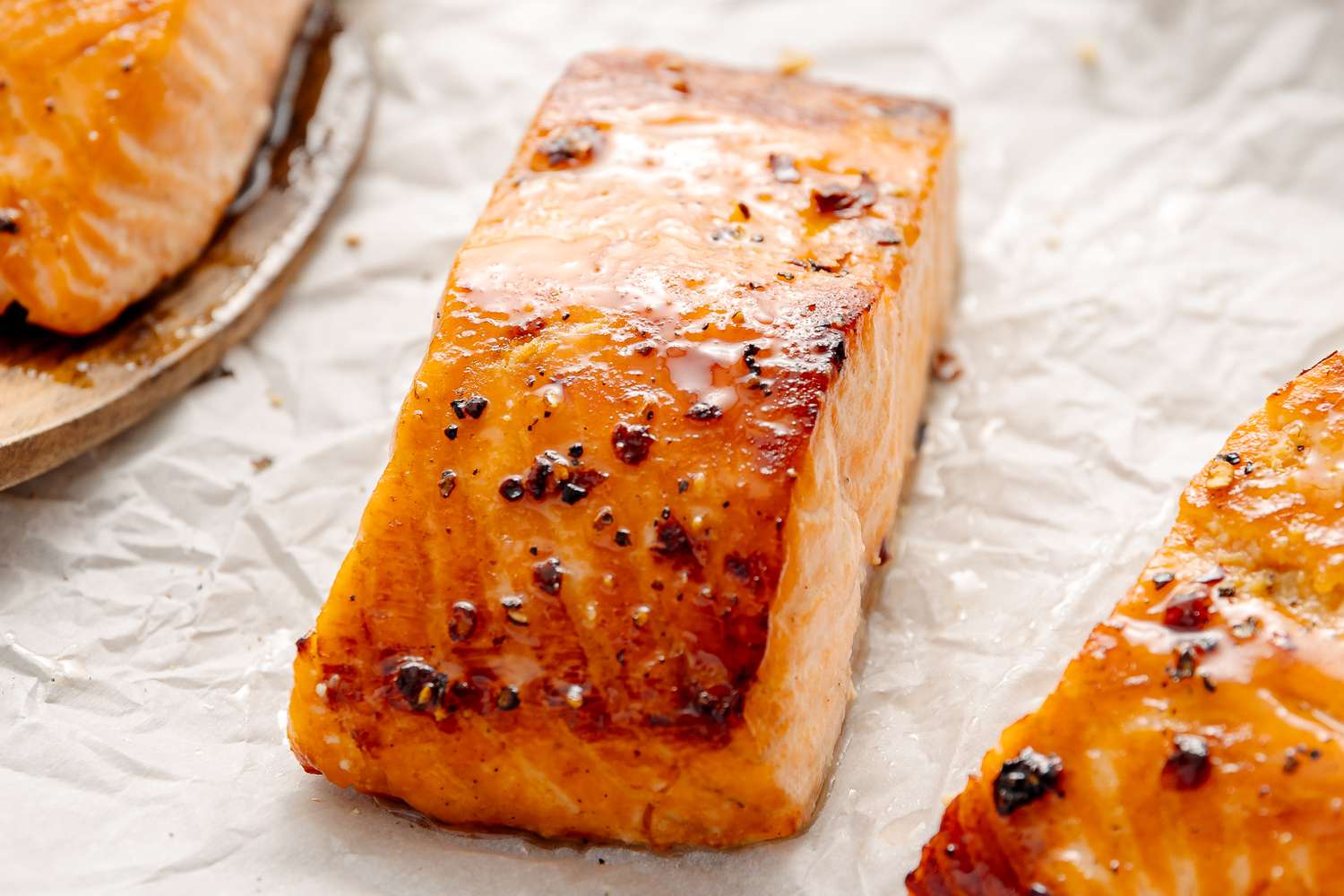
Simply Recipes / Ciara Kehoe
How to Tell the Salmon is Cooked
Salmon can go from perfectly cooked to overcooked in almost an instant. I like mine still silky pink in the middle and a little crisp on the top. Perfectly cooked salmon flakes easily when gently pressed. A digital thermometer inserted into the thickest part of the salmon should register between 125°F and 130°F—this is considered cooked medium.
Serve the Salmon with These Sides
Serve the baked salmon with any of these wonderful side dishes:
- Sugar Snap Pea Salad
- Easy Sauteed Spinach
- Oven Roasted New Potatoes
- Rice Pilaf
- French Green Beans with Butter and Herbs
- Charred Skillet Broccoli
Freeze It!
We’ve all done it. You buy fresh salmon with the best intensions and then don’t quite get to cooking it right away. Cook fresh salmon within 1 to 2 days of purchasing.
You can freeze it too! Simply wrap it with plastic wrap, then with a tight layer of foil. Remove as much air as possible as you wrap the fish. Freeze it for up to 2 months. Defrost it in the fridge for up to 24 hours before you cook it.
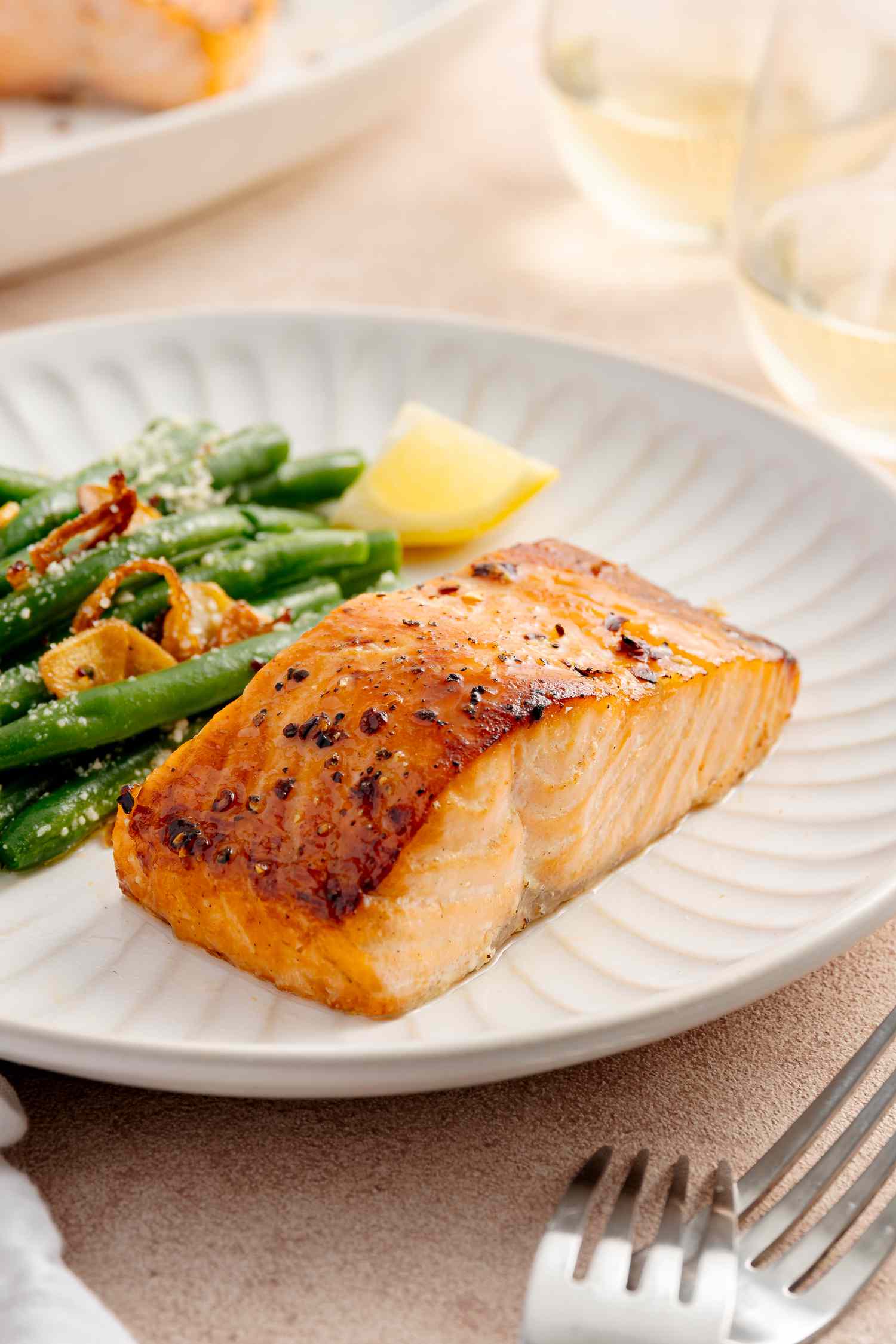
Simply Recipes / Ciara Kehoe
For the Love of Baked Salmon
Salmon with Brown Sugar Glaze
Ingredients
-
2 tablespoons light brown sugar, tightly packed
-
1 tablespoon Dijon mustard
-
1 tablespoon honey
-
1 teaspoon kosher salt
-
1/4 teaspoon freshly ground black pepper
-
1/4 teaspoon crushed red pepper flakes
-
4 (8-ounce) skin-on salmon filets
Method
-
Preheat the oven to 425°F.
Position a rack in the center, line a sheet pan with foil, and set it aside.
![Tray Lined with Foil for Salmon Recipe]()
Simply Recipes / Ciara Kehoe
-
Prepare the glaze:
In a small bowl, stir the brown sugar, mustard, honey, salt, black pepper, and red pepper flakes until smooth and drizzly.
![Bowl of Brown Sugar Glaze for Salmon]()
Simply Recipes / Ciara Kehoe
-
Dry and glaze the salmon:
If you like to eat the salmon skin, pat it very, very dry with a clean dish towel or paper towels. Skip this step if you prefer not to eat the skin.
Place the filets, skin side-down and with space between each filet, on the prepared sheet pan.
Spoon the glaze onto the filets, making sure it fully covers the tops. Use the back of the spoon to spread it out.
![Tray of Salmon Glazed with Brown Sugar Glaze]()
Simply Recipes / Ciara Kehoe
-
Bake and serve:
Bake until the tops are golden brown and crispy in spots. The salmon will feel slightly firm when pressed with your fingers and it should flake easily with a fork, 12 to 14 minutes. If your filets are thin (less than an inch thick), start checking for doneness at the 10-minute mark. A digital thermometer inserted into the thickest part of the salmon should register between 125°F and 130°F—this is considered cooked medium.
Use a spatula to transfer the salmon onto plates and serve warm.
Store leftovers in the fridge for up to 4 days. To reheat, place it on a foil-lined sheet pan and bake it slowly at 300°F until warmed through. This low and slow method will prevent the salmon from drying out too much.
Did you love the recipe? Leave us a review below!
![Salmon with Brown Sugar Glaze on a Platter]()
Simply Recipes / Ciara Kehoe
| Nutrition Facts (per serving) | |
|---|---|
| 507 | Calories |
| 28g | Fat |
| 10g | Carbs |
| 50g | Protein |
| Nutrition Facts | |
|---|---|
| Servings: 4 | |
| Amount per serving | |
| Calories | 507 |
| % Daily Value* | |
| Total Fat 28g | 36% |
| Saturated Fat 5g | 27% |
| Cholesterol 143mg | 48% |
| Sodium 556mg | 24% |
| Total Carbohydrate 10g | 4% |
| Dietary Fiber 0g | 1% |
| Total Sugars 10g | |
| Protein 50g | |
| Vitamin C 9mg | 43% |
| Calcium 42mg | 3% |
| Iron 1mg | 5% |
| Potassium 891mg | 19% |
| *The % Daily Value (DV) tells you how much a nutrient in a food serving contributes to a daily diet. 2,000 calories a day is used for general nutrition advice. | |

